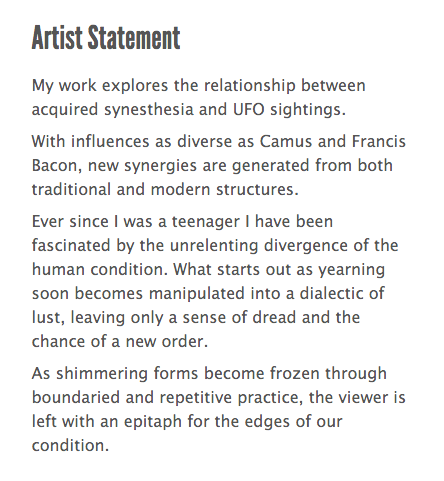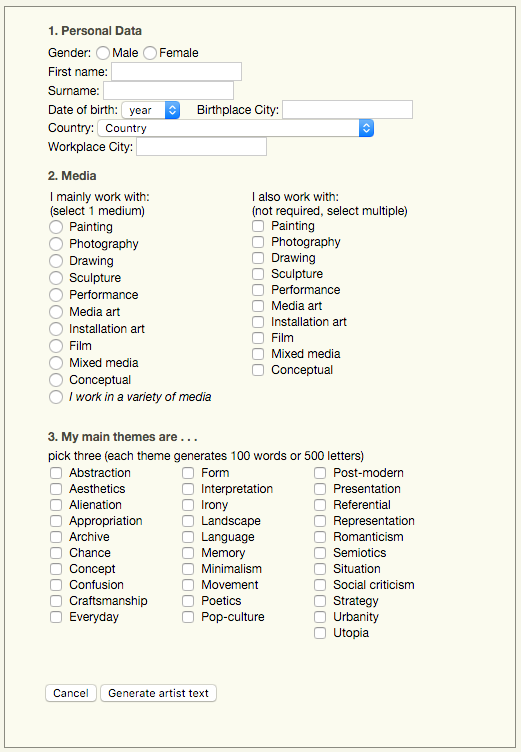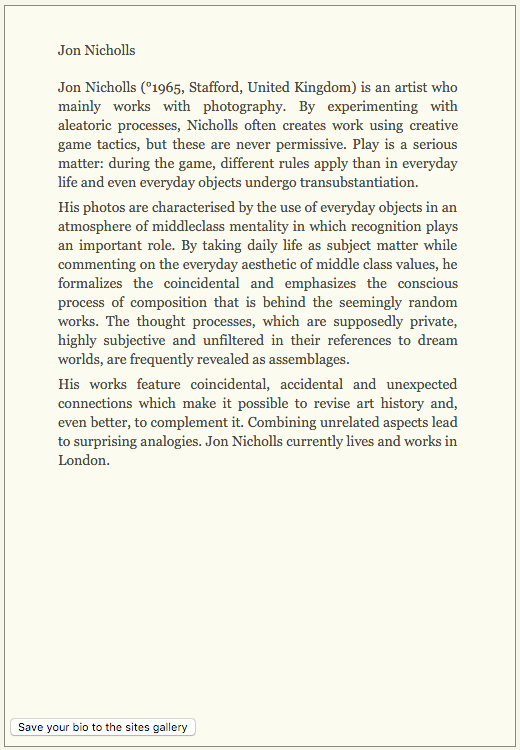Writing an artist's statement might seem like a curious activity for a photography student but I'd like to argue that the process can have all sorts of collateral learning opportunities beyond simply generating the statement itself. For me these include:
- exploring (and questioning) the jargon and lexicon that accompanies contemporary art
- reflecting on personal interests and ways of seeing/photographing
- playing with the identity of an artist/photographer (rather than just an art/photography student)
- thinking about making photographs as a kind of art practice
- experimenting with the relationship between language and images
- crafting and refining an authentic, personal, meaningful (and manageable) piece of writing
- generating ideas for new projects
This is an activity I've explored with Year 12 students at about the time that they are beginning to think about more personal investigations. I'm really interested in the idea that students are 'becoming artists' and, since writing statements that describe a practice (whatever that might be) are central to the business of being an artist today, I've speculated that trying this process out with students might be an interesting way for them to put on the mantle of a contemporary artist and try it out for size.
Here's how I explained the process to my students:
Remember, this is meant to be a fairly light-hearted introduction to writing a statement. You may feel like you don't yet have enough work or know how you feel about your own practice to do this confidently. However, having to think about the following should help you generate some ideas about what you do next. Your statement should:
- let people know how you 'see' the world e.g. you are interested in beauty, in the ordinary and mundane, in the way people interact with their environment, in the hidden or mysterious etc.
- how you feel about photography (and related forms of communication e.g. film, installation etc.) e.g. as a way to document reality, to transform reality, to hold a mirror to the truth, to disguise the truth etc.
- what kinds of subjects interest you e.g. the city, people, the natural world, the built environment etc.
- how you represent these subjects e.g. using abstraction, close-up, using collage, in black and white etc.
- what techniques/processes you might use in the creation of light and lens-based art works e.g. film, digital montage, mixed media etc.
- how you feel about the purpose of your work e.g. to challenge, entertain, mystify, delight etc.
Have fun. Be playful. Be bold. Write things that might be true. Try writing about yourself in the third person "she/he" rather than the first, "I".
Stage 1: The Statement Generator
The 500 letters website is the most sophisticated statement generator that I've found (if you know one that's better please let me know in the comments below). Once you've clicked the 'this application' link, you're presented with the following questionnaire. This gathers enough information about you, your details and interests as an artist, to create a more nuanced statement than other generator like arty b******s, for example.
Stage 2: Refining the statement
I have sometimes asked students to interview each other about their work. You could provide a list of questions or ask the students to create their own. You could read or watch some great interviews online. The purpose of this activity is a bit like the hot-seating I used to do when I taught English. When interviewed, each student has to put on the mantle of the expert and act as if they are an artist/photographer with an existing practice. I provide some general guidelines. No false modesty. All questions must be answered as fully as possible. Interviewers should probe with follow up questions. That sort of thing. It's a good idea for partners to record these interviews (using their phones, for example) so that both parties can concentrate on the discussion.
The opening sentence is important. Spend a bit of time on this. Here's an example that I've adapted from an existing artist's statement:
Photography is my key to the secret garden, my way down the rabbit hole, my looking glass.
I am drawn to sadness, discomfort and unpleasant things such as a dog run over by a car or an old lady wearing too much makeup … I want to see the whole story.
Stage 3: Sharing the statement
Stage 4: Project Proposal (optional)
If the process has been unsuccessful, it's important to reflect on the collateral learning. Writing reasonably substantial pieces of continuous prose has become even more important in the new A level specifications. Consider this a trial run. Studying a particular discipline can be a liminal experience in which students enter a particular threshold but may remain in a kind of limbo state for some time, struggling with troublesome knowledge. Acknowledging and explaining an artistic practice must surely be one of the most important experiences available to an A level arts student. Rome wasn't built in a day.




 RSS Feed
RSS Feed